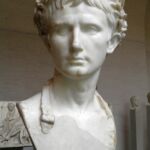Chapters
In the Capitoline Museums we can admire the colossal marble sculpture depicting the Mars Avenger (Mars Ultor). However, this is not an ordinary image of Mars – according to some researchers, the god in this case has the features of Pyrrhus, the great leader and king of Epirus.
Pyrrhus
Living at the turn of the 4th and 3rd century BCE, Pyrrhus (Pyrrhus I) was the king of Epirus coming from the Molloss tribe. His reign was aimed at transforming Epirus into an empire. Consistently striving to achieve this goal, Pyrrhus fought constant wars: incl. with Macedonia, Rome and Carthage. Summoned by the Greek colonies (Magna Graecia), he fought with Rome for domination in southern Italy. During this war, he won a series of victories over the Romans, including those at Heraklea and Ausculum, but the losses suffered in these battles were enormous (especially at Ausculum), hence the popular term “Pyrrhic victory. “.
Pyrrhus was killed during the storming of Argos, fighting in the front lines like Alexander the Great. In the person of the king of Epirus, the Hellenistic world lost one of its most talented leaders and the author of unpreserved military works and diaries. The successor of Pyrrhus on the throne of Epirus was his son – Alexander II.
Colossus from the Capitol
The statue in question is one of those sculptures exhibited in the Capitoline Museums that make the greatest impression on visitors. Mars the Avenger was discovered in the 16th century on the site of the former Forum of Nerva, then also on the basis of details (images of elephants on the fringes of the armor) it was assumed that the prototype of the god was Pyrrhus. The figure initially decorated the houses of Roman patricians, until in 1736 it was taken over by Pope Clement XII and four years later placed on the Capitol.
Most likely, the preserved sculpture is a copy of a figure originally carved in the times of Augustus and placed in the Temple of Mars at Forum of Augustus in Rome, as a cult sculpture. The sculptor, the creator of the original, tried to capture the artistic style used in the 4th century BCE, i.e. in the time of Pyrrhus, in his performance.
The preserved copy was most probably made during the reign of the Antonines, the end of the reign of Trajan, or the beginning of the reign of Hadrian), as indicated by several details (especially the details of the hair and beard), characteristic of the art of this period, and which certainly distinguished it from the Augustinian original. Some researchers believe that the Antoninian corrections prove that the colossus was not used as a cult sculpture, but rather as an ornament at the Forum of Nerva, where it was found.







